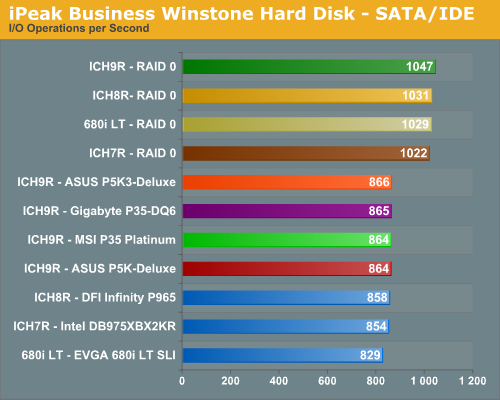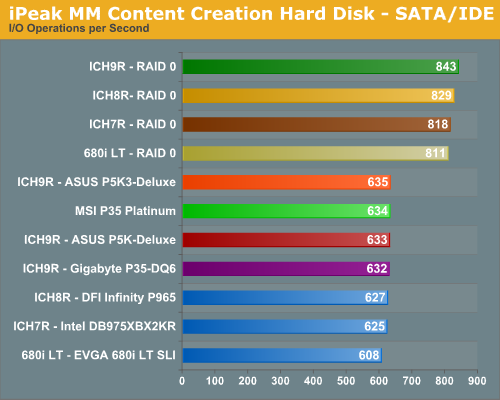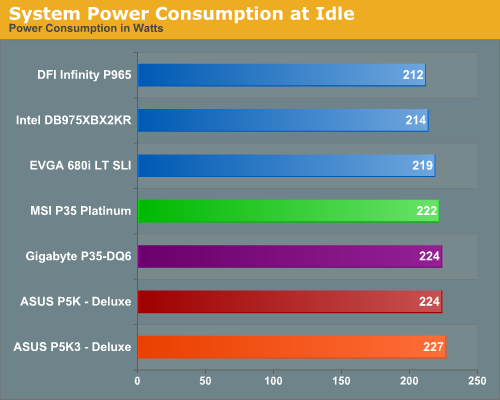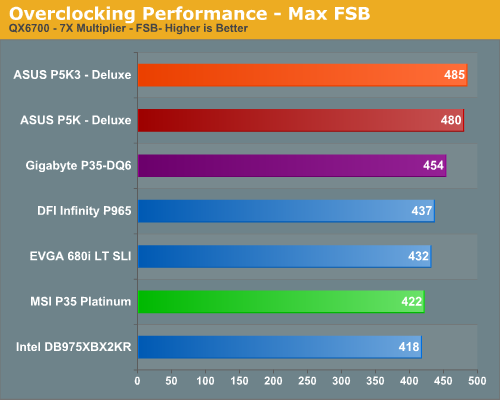Intel P35: Intel's Mainstream Chipset Grows Up
by Gary Key & Wesley Fink on May 21, 2007 3:45 PM EST- Posted in
- CPUs
Disk Controller Performance
The AnandTech iPeak test is designed to measure "pure" hard disk controller performance, and in this case we keep the hard drive as consistent as possible while varying the hard drive controller. The idea is to measure the performance of each hard drive controller with the same hard drive. We report the scores as an average number of I/O operations per second so that higher scores translate into better performance. This number is somewhat meaningless as far as hard disk performance is concerned; however, the scores are useful for comparing "pure" performance of the storage controllers in this case. Results are taken from trace files of Winstones 2004. Due to compatibility issues with Vista, our IPEAK tests are run on Windows XP SP2.

The performance patterns hold steady across both Multimedia Content I/O and Business I/O with the ICH9R outperforming the Intel ICH7R, Intel ICH8R, and NVIDIA 680i chipsets in our tests. Intel told us we should see up to a 4% difference between the ICH9 and ICH8; while our tests do not reveal that, we have noticed a difference in actual usage within Vista, especially when transferring large files. We will have Vista specific tests in the near future. Although our NVIDIA boards generally score lower in these "pure" throughput tests, we find their actual performance in disk intensive applications are generally equal to other solutions during actual usage. We did not experience any RAID 0 issues with the NV controller or drivers under Vista during normal usage but users have reported their RAID arrays degrading over time. We are still investigating these issues.
Power Consumption
As always, we measured power consumption at two states: at idle sitting at the Vista desktop and under load while running our 3DMark06 and Company of Heroes benchmarks. At both settings, EIST/C1E were disabled to show power usage with the system in a normal desktop state.


The surprise is that despite a 16W TDP, the P35 boards actually consume more power than the other chipsets at both idle and load. Even though the DDR3 board has a lower power rating for the memory, it consumes more power than the DDR2 board due to additional circuitry . We can no longer say that NVIDIA is the only high performance chipset approved by OPEC.
FSB Overclocking

Our FSB overclocking results are limited to the quad core QX6700 for this article. We will greatly expand our overclocking results for the roundup that will include five different CPUs. Our ASUS boards overclock the quad core the best at this time thanks to a fairly mature BIOS and great board design. Our Gigabyte and MSI boards have improved greatly over the last week with new BIOS designs and we expect overclocking to improve before the official launch date. In limited testing with the E6600, we were able to hit a 576 FSB on the ASUS boards, 514 on the Gigabyte board, and 508 on the MSI board with the latest BIOS releases.










58 Comments
View All Comments
Wesley Fink - Monday, May 21, 2007 - link
Early boards will be expensive, just like always. The prices will likely drop to the same levels as current P965 boards they replace, with a broad range for P35 boards from basic to "Asus Commando" level gaming boards. It is too early to be discouraged.Comdrpopnfresh - Tuesday, May 22, 2007 - link
I'm willing to bet we'll see them replacing the older boards quickly too. If intel and other manufacturers really want DDR3 to go through, you'll see DDR2 boards disappearing quickly. Its like what happened to s939. Basically the same chips were used for AM2, but the boards and chips quickly dried up and disappeared. The same can be said or PCI-e. In the beginning there wasn't much of a real world benefit, just the theoretical bandwidth increase. Because developments in AGP ceased, we might never know if the switch was necessary.Comdrpopnfresh - Monday, May 21, 2007 - link
If something other than NAND flash could be used, it would be very interesting to see a pci-e 1x board that can house DDR2 memory for use in turbo memory. That way, when people upgrade their ~35 boards to DDR3 when performance and price changes, the DDR2 can be used further. This would make a lot of sense too, because unlike Gigabyte's i-RAM device and logical ramdrives, the high speed, low latency properties of RAM could be used for turbo memory as a way around the 8gb limit of RAM on these cards. And since they are not used for storage, merely access, no redundancy on power supply is needed as with the i-RAM. Someone should start development on this...Comdrpopnfresh - Monday, May 21, 2007 - link
Why would the TDP on the P35 higher if it has no integrated video? Will third-party manufactures implement their own SLI into the P35 given that the reference model only had on x16 pci-e slot? Also, when can we expect to see pci-e2 and more than 4 dimm slots on intel mobos?yacoub - Monday, May 21, 2007 - link
Including a jumper to change the strap setting for the fsb is a nice feature on the MSi board. A little disappointed in the memory comparison test that that board had the lowest bandwidth and most latency. Is that something BIOS updates can improve or is that generally hardware (i.e. board design related)?Gary Key - Monday, May 21, 2007 - link
It is all BIOS tuning in regards to the MSI board. Our first results with the board had the memory performance being equal to the 945P boards. Two BIOS releases later and the improvements have been remarkable. I think MSI is about two BIOS spins behind ASUS and Gigabyte now. Gigabyte finally caught up but ASUS still has the better feature set and options in my opinion.michal1980 - Monday, May 21, 2007 - link
hardocp, seems to take a 180 different outlook on these boards. so werid.skaterdude - Monday, May 21, 2007 - link
What's so weird? Kyle is an extension of AMD's marketing department. He has not cared for Intel in a very long time, at least since he was caught cheating on some Intel benchmarks and was hung out to dry for it. Personally, it is alright to have a favorite company to root for but to do so in such an open and bias way is wrong if you are not running a company specific website. I would not have an issue at all if it was called HardAMD, at least you know what you are viewing is not tainted by free trips, booze, products, and general hostility against a company.
Back on subject....The P35 is a nice upgrade and it may not set the world on fire but it appears Intel listened and improved on a chipset they could have let ride for a lot longer. DDR3 will be interesting and at least the kinks will be worked out by the time X38 and the new processors get here. If I had not already bought a 965 board then P35 would have been the one. I am still miffed about not having a native IDE port as JMicron just plain sucks most of the time.
strikeback03 - Tuesday, May 22, 2007 - link
the P35 does not have native IDE either, and why use an IDE drive anyway?Spoelie - Monday, May 21, 2007 - link
ahum, AMD biased? After reading some of their recent gpu reviews, I thought it was the other way around... Check yourselfanyway, not a worthy upgrade, but a worthy new board. Which is what you could reasonably expect.